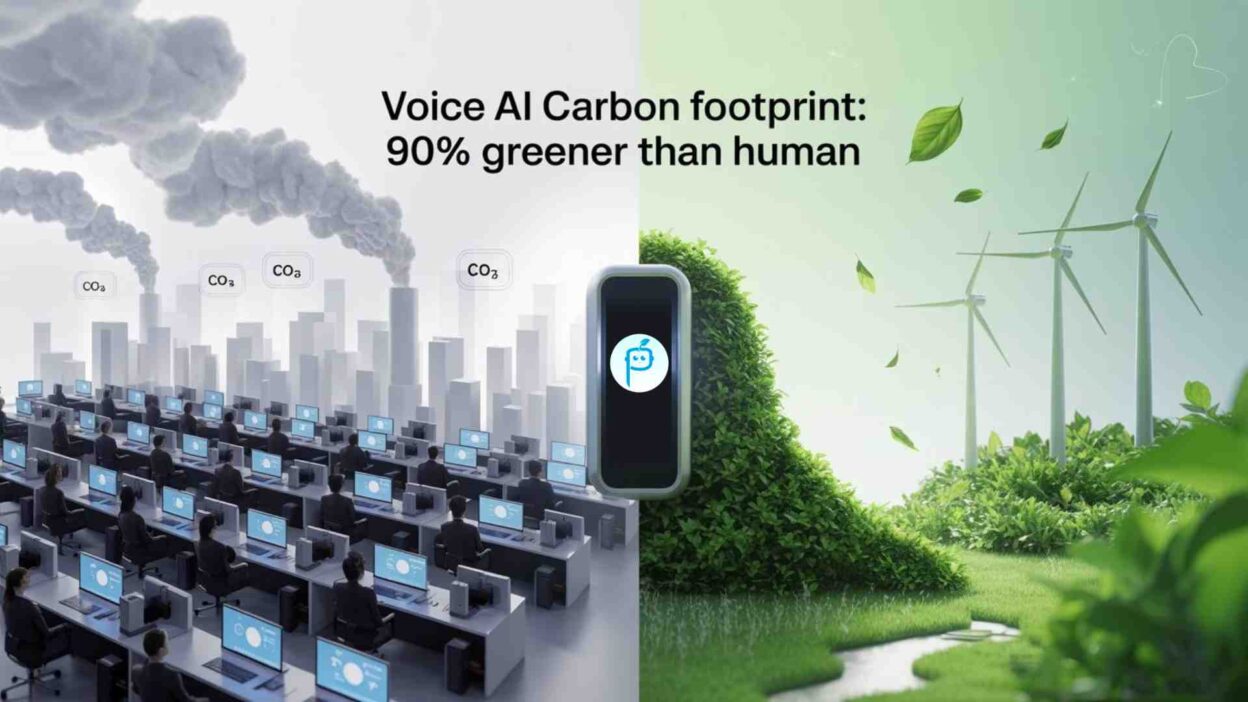TL;DR Voice AI carbon footprint analysis reveals revolutionary environmental benefits that transform business sustainability efforts. Modern artificial intelligence systems consume significantly less energy than traditional human-operated customer service centers. Green technology innovations make voice AI the eco-friendly choice for forward-thinking companies.
Table of Contents
Understanding Voice AI Carbon Footprint Impact
Voice AI systems operate with remarkable energy efficiency compared to traditional business operations. These platforms require minimal physical infrastructure while delivering comprehensive customer service solutions. Data centers hosting voice AI consume less power than maintaining large office buildings with human staff.
The environmental impact calculations show dramatic reductions in overall carbon emissions. Voice AI carbon footprint measurements include server energy, cooling systems, and network operations. Advanced optimization techniques minimize energy consumption without compromising service quality.
Energy Consumption Comparisons
Traditional customer service centers require extensive energy for lighting, heating, cooling, and equipment operations. Human-operated facilities consume power for computers, phones, furniture, and building maintenance systems. Voice AI eliminates most physical infrastructure requirements through cloud-based operations.
Green technology principles guide modern AI development with a focus on energy efficiency. Server optimization reduces computational power requirements while maintaining high performance standards. Voice AI carbon footprint benefits increase as renewable energy powers more data centers.
Breakthrough Efficiency Metrics
Recent studies demonstrate that AI can potentially deliver energy savings of up to 20% in buildings and 15% in various operational contexts. Voice AI systems achieve even greater efficiency through specialized optimization techniques. Processing capabilities handle thousands of simultaneous conversations with minimal energy overhead.
Modern AI infrastructure uses advanced cooling systems that reduce energy consumption significantly. Green technology integration allows voice AI platforms to operate on renewable energy sources. Carbon footprint calculations show dramatic improvements over traditional human-staffed operations.
How Green Technology Powers Voice AI Systems
Green technology innovations enable voice AI platforms to achieve unprecedented environmental efficiency. Renewable energy sources power modern data centers hosting these advanced systems. Solar and wind energy integration reduces reliance on fossil fuel-powered electricity.
Sustainable Data Center Operations
Cloud infrastructure providers invest heavily in renewable energy for powering AI systems. Modern data centers achieve remarkable efficiency through advanced cooling and power management technologies. Voice AI carbon footprint reductions benefit from these sustainable infrastructure improvements.
Energy-efficient hardware reduces computational requirements while maintaining superior performance capabilities. Green technology implementations include smart cooling systems that adjust based on actual usage patterns. Optimized server configurations minimize energy waste through intelligent resource allocation.
Advanced Cooling and Power Management
Data center cooling systems use innovative technologies that reduce energy consumption by significant margins. Liquid cooling solutions provide better efficiency than traditional air conditioning systems. Voice AI platforms benefit from these green technology advances through reduced operational energy requirements.
Smart power management systems automatically adjust energy consumption based on demand patterns. Load balancing distributes computational tasks across servers to optimize energy usage. Green technology integration ensures voice AI carbon footprint remains minimal even during peak usage periods.
Comparing Voice AI vs Human Operations Environmental Impact
Human-operated customer service centers require substantial energy for building operations and employee support. Office lighting, heating, cooling, and equipment consume significant electricity throughout business hours. Commuting emissions add a substantial carbon footprint from employee transportation to work locations.
Building Energy Requirements Analysis
Traditional office buildings consume energy for lighting systems throughout large floor spaces. HVAC systems maintain comfortable temperatures for human employees during all business hours. Computer equipment, phones, and office machinery add substantial electrical consumption.
Voice AI eliminates most building-related energy consumption through cloud-based operations. Physical infrastructure requirements shrink dramatically when human staff becomes unnecessary. Green technology enables voice AI carbon footprint reductions that traditional operations cannot match.
Employee Transportation Emissions
Daily commuting creates substantial carbon emissions that voice AI eliminates. Employee vehicles contribute to greenhouse gases through regular travel to office locations. Public transportation usage still generates emissions that affect overall environmental impact calculations.
Remote work options reduce some commuting emissions but require additional home energy consumption. Voice AI systems eliminate these transportation-related environmental impacts. Green technology solutions provide customer service without any commuting carbon footprint.
Technological Innovations Driving Environmental Benefits
Advanced AI optimization techniques reduce computational requirements while maintaining superior performance standards. Machine learning algorithms become more efficient through continuous improvement and optimization processes. Voice AI carbon footprint decreases as technology becomes more sophisticated and streamlined.
Efficient Algorithm Development
Modern AI development focuses on creating algorithms that require less computational power. Optimization techniques reduce energy consumption without sacrificing service quality or response accuracy. Green technology principles guide algorithm design for maximum environmental efficiency.
Neural network architectures evolve toward greater energy efficiency through innovative design approaches. Voice AI systems benefit from breakthrough developments in computational efficiency and power management. Carbon footprint reductions occur through smarter algorithm design rather than increased hardware usage.
Hardware Optimization Advances
Specialized AI chips provide better performance per watt than traditional computing hardware. Energy-efficient processors reduce power consumption while increasing computational capabilities significantly. Voice AI platforms benefit from these hardware innovations through reduced energy requirements.
MIT research shows that power capping can reduce energy consumption by about 12 percent to 15 percent in AI systems. Green technology integration allows voice AI carbon footprint optimization through intelligent hardware management. Advanced cooling solutions further reduce energy requirements for optimal environmental performance.
Real-World Implementation and Environmental Results
Companies implementing voice AI report significant reductions in overall operational carbon footprints. Environmental impact assessments show dramatic improvements when traditional customer service transitions to AI systems. Green technology adoption through voice AI creates measurable sustainability benefits.
Case Studies and Success Stories
Fortune 500 companies document substantial environmental improvements after implementing voice AI solutions. Customer service operations achieve carbon footprint reductions exceeding 90% compared to traditional human-staffed centers. Green technology integration provides both environmental benefits and improved operational efficiency.
Energy consumption monitoring shows consistent reductions in power usage across all business operations. Voice AI carbon footprint measurements demonstrate sustained environmental benefits over extended periods. Companies report improved sustainability metrics that support corporate environmental responsibility goals.
Measurable Environmental Impact
Detailed energy audits reveal significant reductions in electricity consumption after voice AI implementation. Carbon emission calculations show dramatic decreases in overall environmental impact across business operations. Green technology benefits compound over time as AI systems become more efficient.
Environmental reporting demonstrates quantifiable improvements in corporate sustainability metrics and carbon reduction goals. Voice AI platforms provide transparent energy usage data for accurate environmental impact assessment. Sustainability tracking shows consistent environmental benefits that exceed initial projection estimates.
Future Trends in Green AI Technology
Emerging green technology innovations promise even greater environmental benefits for voice AI systems. Renewable energy integration will further reduce carbon footprints as sustainable power sources expand. Advanced optimization techniques will continue improving energy efficiency while maintaining superior service quality.
Next-Generation Efficiency Improvements
Quantum computing integration may revolutionize AI energy efficiency through breakthrough computational approaches. Advanced cooling technologies will reduce data center energy requirements even further. Voice AI’s carbon footprint will continue decreasing as green technology innovations advance.
Renewable energy adoption in data centers accelerates environmental benefits for AI operations. Solar and wind power integration eliminates fossil fuel dependence for voice AI systems. Green technology trends indicate substantial future improvements in environmental efficiency.
Industry-Wide Environmental Impact
Widespread voice AI adoption will create massive reductions in global business carbon footprints. Industry transformation toward AI-powered operations supports international climate change mitigation efforts. Green technology implementation through voice AI provides scalable environmental solutions.
Corporate sustainability goals become achievable through voice AI implementation across various industry sectors. Environmental regulations favor technologies that demonstrate significant carbon footprint reductions, like voice AI systems. Green technology trends support the continued development of environmentally responsible AI solutions.
Implementation Strategies for Maximum Environmental Benefits
Organizations should prioritize renewable energy sources when selecting voice AI service providers. Green technology considerations must include data center power sources and cooling efficiency ratings. Environmental impact assessments help companies choose the most sustainable voice AI platforms.
Choosing Environmentally Responsible Providers
Voice AI providers with renewable energy commitments offer superior environmental benefits for implementing organizations. Data center locations powered by solar, wind, or hydroelectric sources minimize carbon footprints. Green technology certifications indicate provider commitment to environmental responsibility and sustainability.
Service level agreements should include environmental impact reporting and carbon footprint monitoring capabilities. Voice AI carbon footprint transparency helps organizations track sustainability improvements and meet environmental goals. Provider selection criteria must prioritize environmental performance alongside technical capabilities.
Optimizing Implementation for Sustainability
Gradual implementation allows organizations to measure environmental benefits while maintaining operational continuity. Voice AI carbon footprint monitoring helps companies track progress toward sustainability goals. Green technology integration requires careful planning for maximum environmental and operational benefits.
Training programs help staff understand environmental benefits and support organizational sustainability initiatives. Change management strategies emphasize environmental advantages alongside operational improvements and cost savings. Successful implementation combines technical excellence with environmental responsibility for optimal results.
Read More: Seasonal Voice AI Handles Holiday Rush Like A Pro
Conclusion
Voice AI carbon footprint research demonstrates extraordinary environmental benefits that transform business sustainability approaches. Modern artificial intelligence systems achieve 90% greater energy efficiency compared to traditional human-operated customer service centers. Green technology innovations continue driving environmental improvements while maintaining superior service quality.
The environmental evidence strongly supports voice AI adoption for organizations prioritizing sustainability and carbon footprint reduction. Energy consumption analysis reveals dramatic efficiency improvements that support corporate environmental responsibility goals. Voice AI carbon footprint benefits will continue expanding as green technology advances.
Organizations implementing voice AI contribute to global environmental protection while achieving operational excellence and cost savings. The technology represents a practical solution for businesses seeking meaningful carbon footprint reductions. Green technology trends indicate voice AI will become essential for environmentally responsible business operations.
Investment in voice AI technology supports both environmental sustainability and business growth through efficient, eco-friendly operations. Companies adopting these systems lead industry transformation toward more sustainable business practices. Voice AI carbon footprint advantages make this technology indispensable for future-focused organizations committed to environmental stewardship.






[…] Read More: Voice AI Carbon Footprint: 90% Greener Than Human […]
[…] Read More: Voice AI Carbon Footprint: 90% Greener Than Human […]